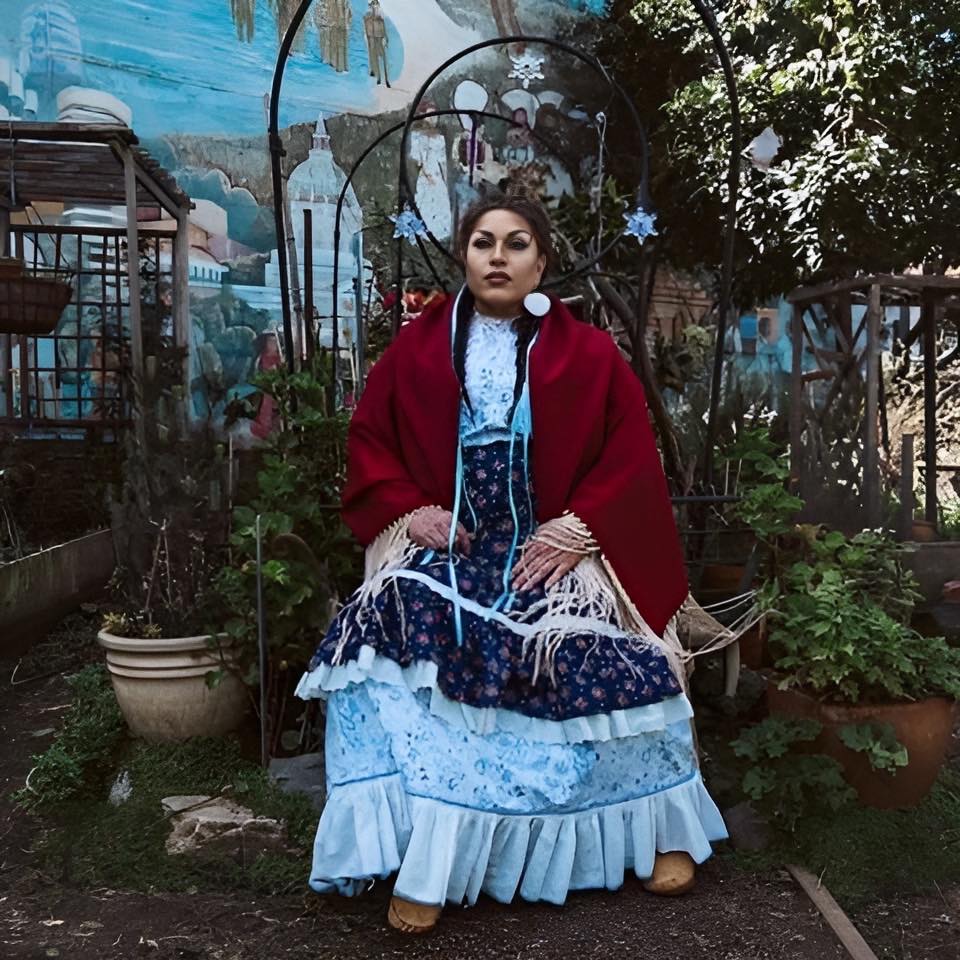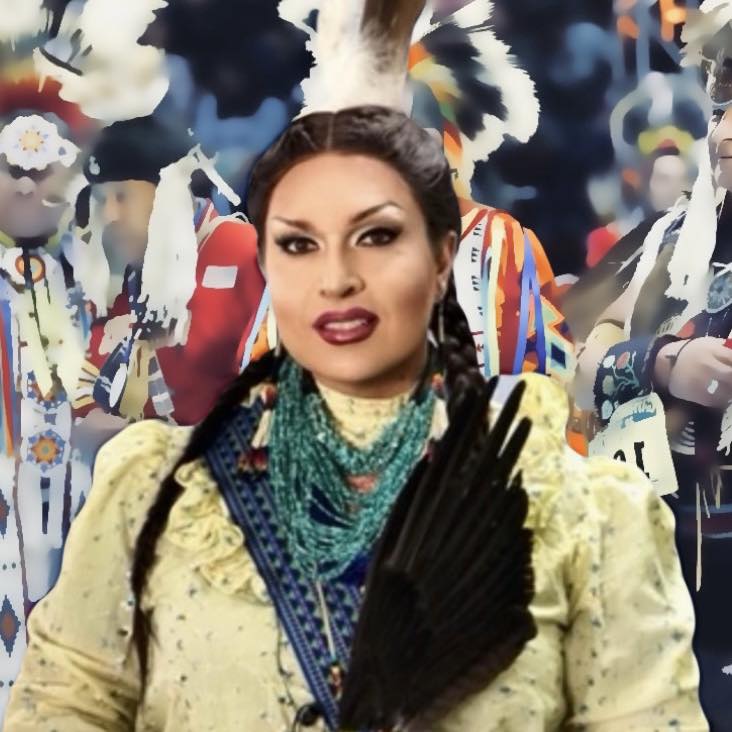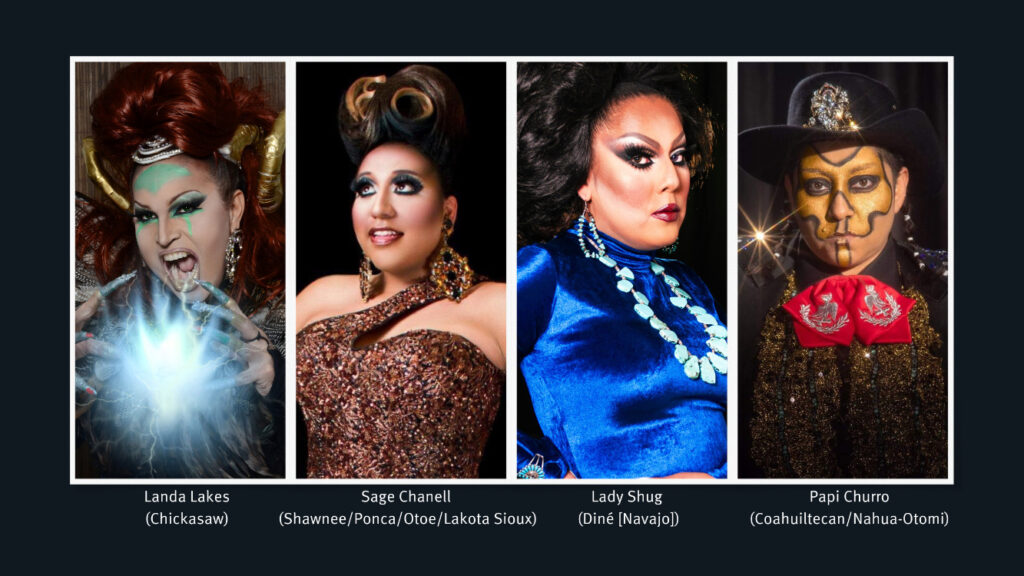Landa Lakes hosts Native Pride extravaganza at The Smithsonian
This Friday night The Smithsonian The Smithsonian’s National Museum of the American Indian in New York City as part of the Pride season themed “Strength in Solidarity,” will be presenting an evening of dynamic and fun performances that showcase the rich diversity of the Indigenous LGBTQIA+ community.
Landa Lakes (Chickasaw) hosts an extravaganza of dance, music, and humor featuring fellow Indigenous drag performers Lady Shug (Diné), Sage Chanell (Shawnee/Ponca/Otoe/Lakota Sioux), and Papi Churro (Coahuiltecan/Nahua-Otomi). The evening’s events will be soundtracked by DJ Jonray (Laguna/Acoma Pueblo).
We had the honor of talking with Landa Lakes about her life and what to expect from the show:
Richard Jones: Hi Landa, it’s wonderful to meet you, can you tell our readers about yourself and how you became Landa Lakes?
Landa Lakes: Sure, here’s the Landa Lakes story. I was born in Oklahoma, what I like to refer to as the backwoods of Oklahoma. And I think just being poor, living on Indian land and the middle of nowhere, helped fuel what Landa Lakes would later on come to be. I grew up in the smallest of towns — I think at its greatest population, Tupelo, OK, had like maybe 450 people and that was at its population boom.
We were rather poor so we had to be creative in a lot of things that we did. And so I think I’ve taken that on, that creativity, and I’ve kept it. So my drag experience started first in Oklahoma under the name of Autumn Westbrook, which I chose because I thought it was really pretty. It’s actually stolen. There is an artist in Oklahoma and her name was Summer Eastbrook. I thought her name was gorgeous. And I was like, I’m going to be Autumn and then I’m just gonna tweak this to Westbrook. And so that’s how I started drag in Oklahoma, basically to get into clubs that I couldn’t get into because I was underage. I would slip in with the drag queens and do shows but I think I started really doing shows at the Rec Room which was an 18 and over club in in Oklahoma City and that was sort of fun and then after I left and went and joined the Navy.
After I got out of the Navy, I settled down in San Francisco. And it took me a while, I was in a relationship for a long time and the person did not want me doing drag, even though when they met me I was doing drag. So I didn’t do drag again until I broke up with them and started a new relationship. Here’s a small story: When I was first dating this new person in my life I said Make yourself at home. Feel free here, I said. But don’t, whatever you do, go in this closet. So I went to take a shower and of course he went into that closet. And that closet of course contained my wig and my shoes and these really beautiful high boots that I thought were so great and precious. So he learned of my drag queen past. And then I started doing drag again shortly after that.
I didn’t want to go under Autumn Westbrook anymore. I felt like I had gone a little bit beyond Autumn Westbrook and I wanted to bring in some of my indigeneity. I grew up my whole life as an Indigenous child. I did all the things that I was supposed to do and I attended a lot of different Indigenous youth programs and stuff like that. So I was heavy into a lot of Indigenous things before I ever came to San Francisco. So at this time, i thought OK, I want to re embrace who I am. I was a drag queen, but I also want to embrace the fact that I was indigenous. Around 2004 I retired Autumn Westbrook as a name, and I wanted something that was a little more tongue in cheek.

I thought of Land of Lakes. Making fun of the Land of Lakes mascot was how I did that. I usually tell people that I’m like Land O Lakes, but only I don’t have an O, I have an A. And what’s really funny is I was sort of really making fun of the mascot and I thought it was sort of funny and everything. But then a lot of people kept giving me Mini Moos and all these watches that had Land O Lakes product printed on it and even a recipe book. I’m not really a big fan. I just I use the name and make fun of it, not to select it.
When I started out again I joined this very enormous club in San Francisco at the time, it was known under the name of “Trannyshack”. Of course, people don’t use that name anymore, even at the time, I think it was a little triggering. But I think they wanted to be alternative. It was a lot of shock queens and everything else. So I joined into that. The first time I hit the stage it was at a contest. It was the “T-Shack” Star Search contest. I came on and I won!!!
RJ: Did you do more work with T-Shack?
LL: One of the things that I took away from T-Shack back in the day was storytelling. Because, although their stuff was very shocking, a lot of times it was storytelling at the same time and so it made it different from the usual glamour drag. And that’s the sort of drag that I was used to in Oklahoma. But this was all about storytelling. So it just sort of changed, how I did drag because I started using it more as a way of telling stories and then combining it with some Indigenous stories and Indigenous happenings, Indigenous politics. It’s sort of like reeducated my drag.
Richard: Is that where you found your activism then, when you were in San Francisco?
LL: Probably what started my activism was actually when I was a little kid. When I was very young, my father joined the American Indian Movement while he was at Murray State College down at Tishomingo. I didn’t really understand it. But one of the things my father said at the time is that that you had to stand up for your rights because if you didn’t then people would run all over you and so that just sort of stuck in my mind.
So when I was at the University of Oklahoma, we had this organization called the GLA, gay, lesbian alliance as it was known back then. And so I became active both in that as well as AISSES, the American Indian Student Science and Engineering Society and another thing called AISA, which was the American Indian Student Association. And then when we came around to 1989 UM in Oklahoma, they wanted to do a lot of different celebrations for The Run of 89 celebrating colonizing Oklahoma. I had a good friend at the at that time named Ben and Ben had been an activist while he while he was actually in prison and in McAllister Oklahoma. We started working on different things to bring light to some of the things that was happening within the indigenous community at the time. So I would say that my activism really started there and with ASA, AISSES and the GLA, that’s I think when my activism really started. And then around 2004 I started combining my activism into my drag.
RJ: What’s important to you to still to fight for today?
LL: I think there’s a lot of stuff that still needs to be fought for today. I think that everybody thinks that we now live in a very progressive society, but we still don’t. I think that I still have to fight sometimes, even within my own tribe or certain truths that I think that for some reason get diminished or whatever. The idea that being a part of the LGBT community is very like what we call Naholo or Caucasian sort of a thing. It’s not true. We’ve always had it within our tribe as well. And I think it’s important that we recognize that instead of looking at it as a peculiar sort of thing that happened because of colonization. It’s not a result of colonization. It’s just something that has always been within our societies. And I think there’s that you can fight. Or we can continue to fight for UM for representation. I think that the invisibility of native people is still a shame.
Things are getting better, but sometimes you have to really fight for it. And I think that we often have to reconcile the past with our present. I think that when UM started pulling out bodies from these UM residential schools up in Canada and then they started our own research into it here in the United States to add different boarding schools. These are important things, important topics, and I don’t think that they should be diminished or completely ignored. I think a lot of times when you think about the residential schools, you only remember the 215 that was found at the very first one. Nobody even says anything about the fact that they went to another residential school and found 7000 and that barely made the news. The 215 was all that made the news. So, there’s a lot of invisibility that takes place. And I think that as indigenous people, we feel like we’re connected to the land. And if we’re connected to the land, then we want to protect the land. And we might want to make sure that we have protections there. So, there’s still so much to fight for.
RJ: And then what can we expect from the show on Friday in New York?
LL: What you can expect from the show is there’s going to be some funny moments, there’s going to be some glamorous moments, but there is going to be politics. That hasn’t changed. We’re still going to be sharing some of the Indigenous experience as well. We’re still doing the storytelling that we were known for. So that’s what people can expect. They can expect a little bit of fun, a little bit of lightness, but expect some serious things too. I do believe it’s going to be recorded as well, So if you can’t come and see us live, you can watch online sometime afterwards.

RJ: As a non-native American queer person, What’s the best thing myself or anybody else like me could do to support the queer Native American community?
LL: One of the things that I would like to say, for people who really want to support and everything: come support some of our stuff. Come to one of our two spirit pow wows. The thing about it is you come and you’re just going to enjoy yourself. It’s just giving you a greater understanding of who we are. And invite your friends. It raises visibility that native people are still here. That we’re not a forgotten relic of the past. We’re still present.
RJ: We are not intruding then if we were to come and support a pow wow?
LL: Not at all. We have this set up. When we started the two spirit pow wow, we wanted to be welcoming to all. We want people to come in and see our culture. The only thing that we would request, of course, is don’t come in the Halloween store costume stuff. Don’t come in a headdress, don’t dress up. Just come and enjoy our culture. We appreciate that and one of the things that we don’t need to remind people, but sometimes we do, is that we’re inviting you to enjoy our culture. We’re not inviting you to take over our culture.

Landa Lakes will be hosting the Native Pride Extravaganza on JUNE 23, 2023, 7 – 9 PM hosted at the Diker Pavilion, Smithsonian’s National Museum of the American Indian, 1 Bowling Green, nr. Broadway. Visit americanindian.si.edu.
Please consider donating to the Bay Area, American Indian, Two Spirits organization.






